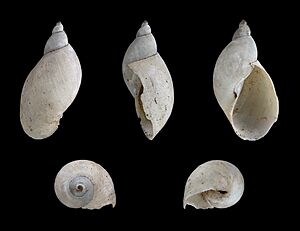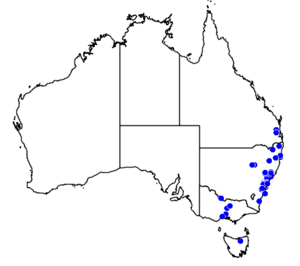American ribbed fluke snail facts for kids
Quick facts for kids American ribbed fluke snail |
|
|---|---|
 |
|
| Scientific classification | |
| Genus: |
Pseudosuccinea
|
| Species: |
columella
|
| Synonyms | |
|
Lymnaea columella Say, 1817 |
|
Pseudosuccinea columella is a type of freshwater snail often called the American ribbed fluke snail. It's a snail that breathes air and lives in water. It belongs to a group known as pond snails. This snail is important because it can carry a tiny worm called a liver fluke. This fluke is a parasite that can affect farm animals like sheep.
Contents
Where Does This Snail Live?
This snail can be found in many places around the world.
Native Homes
The Pseudosuccinea columella snail originally comes from North America and Europe. In North America, it lives from places like New Brunswick and Manitoba in Canada, all the way through the eastern United States, and down to Central and South America.
The exact first place this snail was found is not known. But scientists think it was somewhere near Philadelphia, in the United States.
New Homes Around the World
This snail has also spread to many new places. It was brought to Australia and other parts of Europe.
Here are some places where the Pseudosuccinea columella snail has been introduced:
- Western United States (you can see a map of its spread in the US here)
- Puerto Rico
- Venezuela
- Brazil, especially in Rio Grande do Sul
- Argentina
- Australia
- South Africa (since 1942)
- Other countries in Africa
- Many Pacific islands
In Europe, it has spread to:
- Switzerland (in Basel)
- Austria (in Villach)
- Hungary
- Greece (in Nómos Florina)
- Menorca (a Spanish island)
- France
- Portugal and Madeira Island
- Czech Republic (often found in greenhouses)
- Latvia (also often found in greenhouses)
What Does This Snail Look Like?
The shell of the Pseudosuccinea columella snail looks a lot like shells from a different snail group called Succinea.
The shell is usually brown and thin. It's also see-through and has very fine lines on it. The top of the shell is pointed. The shell has about 3 to 4 turns, called whorls, which are slightly rounded. The last turn is the biggest part of the shell. The opening of the shell is oval-shaped.
The shell is usually about 8 to 13 millimeters wide. It can be 15 to 20 millimeters tall.
The snail itself is dark with some whitish spots. Its eyes are small and black. They are located at the bottom of its tentacles.
Where Does This Snail Live?
In North America, the Pseudosuccinea columella snail likes to live in still water. You can find it at the edges of lakes, ponds, and slow-moving, muddy streams. It often hides among lily pads and reeds, or on sticks and mud.
In Europe, these snails are mostly found in greenhouses. This is because greenhouses are warm. They sometimes live outside in places like Austria and Hungary. However, they need warm water and cannot survive cold Central European winters. They are also found on floating leaves of water plants. In northern Greece, they were found near a road in a spring.
What Parasites Does This Snail Carry?
The Pseudosuccinea columella snail can carry different types of parasites. These parasites use the snail as a temporary home.
- In North America, this snail is the main host for Fasciola hepatica. This is the liver fluke that can affect farm animals.
- This snail can also be a host for another type of fluke called Fascioloides magna.
- It can also carry the young forms, called cercariae, of a worm called Telorchis sp.
Images for kids




